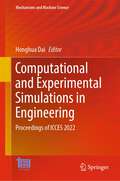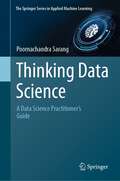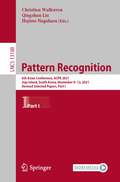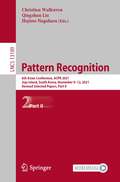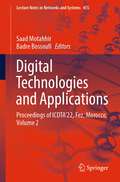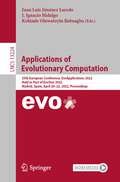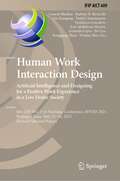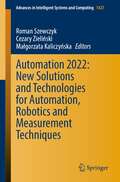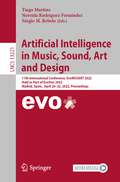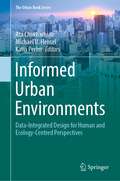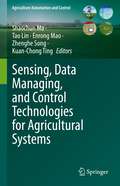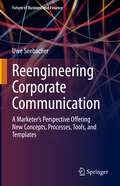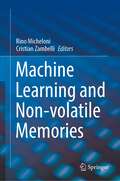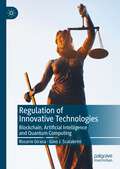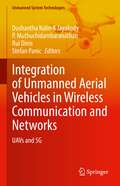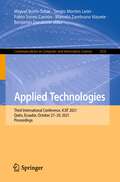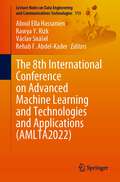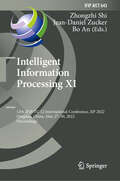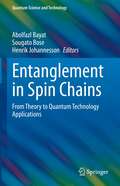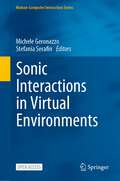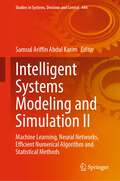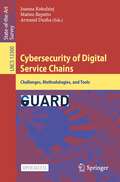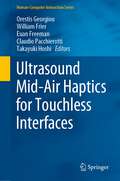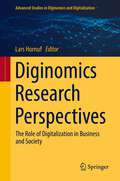- Table View
- List View
Computational and Experimental Simulations in Engineering: Proceedings of ICCES 2022 (Mechanisms and Machine Science #119)
by Honghua DaiThis book gathers the latest advances, innovations, and applications in the field of computational engineering, as presented by leading international researchers and engineers at the 27th International Conference on Computational & Experimental Engineering and Sciences (ICCES), held online on January 8-12, 2022. ICCES covers all aspects of applied sciences and engineering: theoretical, analytical, computational, and experimental studies and solutions of problems in the physical, chemical, biological, mechanical, electrical, and mathematical sciences. As such, the book discusses highly diverse topics, including composites; bioengineering & biomechanics; geotechnical engineering; offshore & arctic engineering; multi-scale & multi-physics fluid engineering; structural integrity & longevity; materials design & simulation; and computer modeling methods in engineering. The contributions, which were selected by means of a rigorous international peer-review process, highlight numerous exciting ideas that will spur novel research directions and foster multidisciplinary collaborations.
Thinking Data Science: A Data Science Practitioner’s Guide (The Springer Series in Applied Machine Learning)
by Poornachandra SarangThis definitive guide to Machine Learning projects answers the problems an aspiring or experienced data scientist frequently has: Confused on what technology to use for your ML development? Should I use GOFAI, ANN/DNN or Transfer Learning? Can I rely on AutoML for model development? What if the client provides me Gig and Terabytes of data for developing analytic models? How do I handle high-frequency dynamic datasets? This book provides the practitioner with a consolidation of the entire data science process in a single “Cheat Sheet”.The challenge for a data scientist is to extract meaningful information from huge datasets that will help to create better strategies for businesses. Many Machine Learning algorithms and Neural Networks are designed to do analytics on such datasets. For a data scientist, it is a daunting decision as to which algorithm to use for a given dataset. Although there is no single answer to this question, a systematic approach to problem solving is necessary. This book describes the various ML algorithms conceptually and defines/discusses a process in the selection of ML/DL models. The consolidation of available algorithms and techniques for designing efficient ML models is the key aspect of this book. Thinking Data Science will help practising data scientists, academicians, researchers, and students who want to build ML models using the appropriate algorithms and architectures, whether the data be small or big.
Pattern Recognition: 6th Asian Conference, ACPR 2021, Jeju Island, South Korea, November 9–12, 2021, Revised Selected Papers, Part I (Lecture Notes in Computer Science #13188)
by Christian Wallraven Qingshan Liu Hajime NagaharaThis two-volume set LNCS 13188 - 13189 constitutes the refereed proceedings of the 6th Asian Conference on Pattern Recognition, ACPR 2021, held in Jeju Island, South Korea, in November 2021. The 85 full papers presented were carefully reviewed and selected from 154 submissions. The papers are organized in topics on: classification, action and video and motion, object detection and anomaly, segmentation, grouping and shape, face and body and biometrics, adversarial learning and networks, computational photography, learning theory and optimization, applications, medical and robotics, computer vision and robot vision.
Pattern Recognition: 6th Asian Conference, ACPR 2021, Jeju Island, South Korea, November 9–12, 2021, Revised Selected Papers, Part II (Lecture Notes in Computer Science #13189)
by Christian Wallraven Qingshan Liu Hajime NagaharaThis two-volume set LNCS 13188 - 13189 constitutes the refereed proceedings of the 6th Asian Conference on Pattern Recognition, ACPR 2021, held in Jeju Island, South Korea, in November 2021. The 85 full papers presented were carefully reviewed and selected from 154 submissions. The papers are organized in topics on: classification, action and video and motion, object detection and anomaly, segmentation, grouping and shape, face and body and biometrics, adversarial learning and networks, computational photography, learning theory and optimization, applications, medical and robotics, computer vision and robot vision.
Digital Technologies and Applications: Proceedings of ICDTA’22, Fez, Morocco, Volume 2 (Lecture Notes in Networks and Systems #455)
by Saad Motahhir Badre BossoufiThis book presents volume 2 of selected research papers presented at the Second International Conference on Digital Technologies and Applications (ICDTA 22), held at Sidi Mohamed Ben Abdellah University, Fez, Morocco, on 28–29 January 2022. Highlighting the latest innovations in digital technologies as: Artifiscial Intelligence, Internet of things, Embedded systems, Network Technology, information processing and their applications in several areas as hybrid vehicles, renewable energy, Mechatronics, Medicine… The respective papers will encourage and inspire researchers, industry professionals, and policymakers to put these methods into practice.
Applications of Evolutionary Computation: 25th European Conference, EvoApplications 2022, Held as Part of EvoStar 2022, Madrid, Spain, April 20–22, 2022, Proceedings (Lecture Notes in Computer Science #13224)
by Juan Luis Jiménez Laredo J. Ignacio Hidalgo Kehinde Oluwatoyin BabaagbaThis book constitutes the refereed proceedings of the 25th International Conference on Applications of Evolutionary Computation, EvoApplications 2022, held as part of Evo*2022, in April 2022, co-located with the Evo*2022 events EuroGP, EvoCOP, and EvoMUSART. The 46 revised full papers presented in this book were carefully reviewed and selected from 67 submissions.
Human Work Interaction Design. Artificial Intelligence and Designing for a Positive Work Experience in a Low Desire Society: 6th IFIP WG 13.6 Working Conference, HWID 2021, Beijing, China, May 15–16, 2021, Revised Selected Papers (IFIP Advances in Information and Communication Technology #609)
by Arminda Lopes Torkil Clemmensen José Abdelnour-Nocera Frederica Gonçalves Ganesh Bhutkar Barbara R. Barricelli Qin Xiangang Fei Lyu Ronggang Zhou Wenjun HouThis book constitutes the thoroughly refereed post-conference proceedings of the 6th IFIP WG 13.6 Working Conference on Human Work Interaction Design, HWID 2021, held in Beijing, China, in May, 2021. The 10 revised and extended full papers presented were carefully selected for inclusion in this volume. The papers deal with the analysis and interaction design of a variety of complex work and life contexts found in different business and application domains. They focus on interaction design for work engagement taking usability of interactive systems to the next level by providing employees pleasurable and meaningful experiences via the tools used at work. The papers are organized the following topical sub-headings: Trends in human Work Interaction Design; Workplace & work experience Analysis for Interaction Design; and Artificial Intelligence (AI) for Human Work.
Automation 2022: New Solutions and Technologies for Automation, Robotics and Measurement Techniques (Advances in Intelligent Systems and Computing #1427)
by Roman Szewczyk Cezary Zieliński Małgorzata KaliczyńskaThis book presents the unique result of discussion among interdisciplinary specialists facing recent industrial and economic challenges. It contains papers authored by both scientists and practitioners focused on an interdisciplinary approach to developing measuring techniques, robotic and mechatronic systems, industrial automation, numerical modelling and simulation, and application of artificial intelligence techniques required by the transformation leading to Industry 4.0. We strongly believe that the solutions and guidelines presented in this book will be useful to both researchers and engineers facing problems associated with developing cyber-physical systems for global development.
Artificial Intelligence in Music, Sound, Art and Design: 11th International Conference, EvoMUSART 2022, Held as Part of EvoStar 2022, Madrid, Spain, April 20–22, 2022, Proceedings (Lecture Notes in Computer Science #13221)
by Tiago Martins Nereida Rodríguez-Fernández Sérgio M. RebeloThis book constitutes the refereed proceedings of the 10th European Conference on Artificial Intelligence in Music, Sound, Art and Design, EvoMUSART 2022, held as part of Evo* 2022, in April 2022, co-located with the Evo* 2022 events, EvoCOP, EvoApplications, and EuroGP. The 20 full papers and 6 short papers presented in this book were carefully reviewed and selected from 66 submissions. They cover a wide range of topics and application areas, including generative approaches to music and visual art, deep learning, and architecture.
Informed Urban Environments: Data-Integrated Design for Human and Ecology-Centred Perspectives (The Urban Book Series)
by Katia Perini Michael U. Hensel Ata ChokhachianThis book collects ground-breaking works on the actual and potential impact of big data and data-integrated design for resilient urban environments, including human- and ecology-centred perspectives. Comprehending and designing for urban social, demographic and environmental change is a complex task. Big data, data structuring, data analysis (i.e. AI and ML) and data-integrated design can play a significant role in advancing approaches to this task. The themes presented in this book include urban adaptation, urban morphology, urban mobility, urban ecosystems, urban climate, urban ecology and agriculture. Given the compound nature of complex sustainability problems, most chapters address the correlation between several of these themes. The book addresses practitioners, researchers and graduate students concerned with the rapidly increasing role of data in developing urban environments.
Sensing, Data Managing, and Control Technologies for Agricultural Systems (Agriculture Automation and Control)
by Shaochun Ma Tao Lin Enrong Mao Zhenghe Song Kuan-Chong TingAgricultural automation is the emerging technologies which heavily rely on computer-integrated management and advanced control systems. The tedious farming tasks had been taken over by agricultural machines in last century, in new millennium, computer-aided systems, automation, and robotics has been applied to precisely manage agricultural production system. With agricultural automation technologies, sustainable agriculture is being developed based on efficient use of land, increased conservation of water, fertilizer and energy resources. The agricultural automation technologies refer to related areas in sensing & perception, reasoning & learning, data communication, and task planning & execution. Since the literature on this diverse subject is widely scattered, it is necessary to review current status and capture the future challenges through a comprehensive monograph.In this book we focus on agricultural automation and provide critical reviews of advanced control technologies, their merits and limitations, application areas and research opportunities for further development. This collection thus serves as an authoritative treatise that can help researchers, engineers, educators, and students in the field of sensing, control, and automation technologies for production agriculture.
Reengineering Corporate Communication: A Marketer’s Perspective Offering New Concepts, Processes, Tools, and Templates (Future of Business and Finance)
by Uwe SeebacherThis book employs the latest insights from modern marketing into the theory and practice of corporate communication, including the main stages and goals, and highlights the key potentials for the field. It briefly presents the essential features of the methodological and structural sciences in order to illustrate to the reader how, from a marketer's point of view, these new insights can be derived objectively, reliably, and validly for the field of corporate communication according to scientific criteria. The book then introduces the maturity model for modern corporate communication and describes which fields of activity must be gone through in order to be able to implement the change management process towards corporate communication excellence efficiently and effectively. Building on this, it introduces and defines the most important new concepts of corporate communication in the twenty-first century and thus clearly delineates the field of research for this corporate function in the coming years. The book goes on to address the important areas of IT and HR in order to provide a 360° view of the developments to be realized in the field of corporate communication. A “CC self-test” at the end of the book is intended to help the reader immediately recognize where their own organization stands and, against this backdrop, to be able to start the necessary activities towards corporate communication excellence immediately on the basis of the maturity model. “Prof. Dr. Uwe Seebacher takes us on a timely and informative read on what could be the biggest crisis for Corporate Communications – remaining stagnant in a time of great change. With rich context and fine detail, he illuminates the opportunities to reengineer Corporate Communications and quantify its role in truly impacting business. From the importance of predictive intelligence underpinned by authenticity and empathy to building trust, this book is a guide for successful business in the 21st Century. I highly recommend it.”Heidi Eusebio, Strategist and Executive Director, Edelman "Uwe Seebacher has once again demonstrated in a well-founded manner what methodological and structural science is capable of - namely, to precisely logically derive the long overdue process of change in the field of corporate communications and thereby make it comprehensible. But he also takes the important next step of operationalizing his thoughts in a directly measurable way by providing an easy applicable concrete process model for reengineering corporate communication with many tips, templates and inputs for HR and IT.“ Miguel Gimenez de Castro, Head Of Communications Spain, Portugal, Greece and Israel, IBM
Machine Learning and Non-volatile Memories
by Rino Micheloni Cristian ZambelliThis book presents the basics of both NAND flash storage and machine learning, detailing the storage problems the latter can help to solve. At a first sight, machine learning and non-volatile memories seem very far away from each other. Machine learning implies mathematics, algorithms and a lot of computation; non-volatile memories are solid-state devices used to store information, having the amazing capability of retaining the information even without power supply. This book will help the reader understand how these two worlds can work together, bringing a lot of value to each other. In particular, the book covers two main fields of application: analog neural networks (NNs) and solid-state drives (SSDs).After reviewing the basics of machine learning in Chapter 1, Chapter 2 shows how neural networks can mimic the human brain; to accomplish this result, neural networks have to perform a specific computation called vector-by-matrix (VbM) multiplication, which is particularly power hungry. In the digital domain, VbM is implemented by means of logic gates which dictate both the area occupation and the power consumption; the combination of the two poses serious challenges to the hardware scalability, thus limiting the size of the neural network itself, especially in terms of the number of processable inputs and outputs. Non-volatile memories (phase change memories in Chapter 3, resistive memories in Chapter 4, and 3D flash memories in Chapter 5 and Chapter 6) enable the analog implementation of the VbM (also called “neuromorphic architecture”), which can easily beat the equivalent digital implementation in terms of both speed and energy consumption.SSDs and flash memories are strictly coupled together; as 3D flash scales, there is a significant amount of work that has to be done in order to optimize the overall performances of SSDs. Machine learning has emerged as a viable solution in many stages of this process. After introducing the main flash reliability issues, Chapter 7 shows both supervised and un-supervised machine learning techniques that can be applied to NAND. In addition, Chapter 7 deals with algorithms and techniques for a pro-active reliability management of SSDs. Last but not least, the last section of Chapter 7 discusses the next challenge for machine learning in the context of the so-called computational storage.No doubt that machine learning and non-volatile memories can help each other, but we are just at the beginning of the journey; this book helps researchers understand the basics of each field by providing real application examples, hopefully, providing a good starting point for the next level of development.
Regulation of Innovative Technologies: Blockchain, Artificial Intelligence and Quantum Computing
by Rosario Girasa Gino J. ScalabriniThis book explores the regulation of emerging technologies. Developments such as bitcoin (based on blockchain technology), artificial intelligence, quantum computing, and other technical advances have the potential to revolutionize many aspects of everyday life. As with other significant occurrences, especially when coupled by financial rewards, there are the inevitable attempts to reap gains unlawfully. This book examines the legal and regulatory enactments that attempt to undermine the risks to society as well as the dangers to individual freedoms that the technologies present when abused by governmental and non-governmental authorities. Included are discussions of the dangers to the right of privacy posed by facial recognition, physical location tracking, automated license plate recognition (ALPR) and other evolving applications of technology. This book is an invaluable resource for those interested in the regulation of emerging technologies particularly as they relate to blockchain, artificial intelligence, and the most current advances in quantum computing. Emphasis is focused on invasion of privacy, particularly by government authorities, antitrust implications of private companies and the efforts of international entities to counter alleged abuses by them.
Integration of Unmanned Aerial Vehicles in Wireless Communication and Networks: UAVs and 5G (Unmanned System Technologies)
by Dushantha Nalin K Jayakody P. Muthuchidambaranathan Rui Dinis Stefan PanicThis book presents a comprehensive overview of Unmanned Arial Vehicles (UAV) and their integration of wireless communications and networks, including inherent challenges and open access concerns. The authors present the latest technologies associated with UAV-assisted wireless communications and networks by linking their association with 5G Wireless Networks. The authors include positioning of UAV, coagulation attack of UAV, and the green prospective of UAV communication systems. The book explains how the UAV can be integrated with 5G wireless schemes such as ultra-reliable, low density communications, full duplex, and non-orthogonal multiple access (NOMA) for 5G. This book targets graduate students, researchers, and industry personnel.
Applied Technologies: Third International Conference, ICAT 2021, Quito, Ecuador, October 27–29, 2021, Proceedings (Communications in Computer and Information Science #1535)
by Miguel Botto-Tobar Marcelo Zambrano Vizuete Pablo Torres-Carrión Sergio Montes León Benjamin DurakovicThis volume constitutes the refereed proceedings of the Third International Conference on Applied Technologies, ICAT 2021, held in Quito, Ecuador, in October 2021. The 40 papers were carefully reviewed and selected from 201 submissions. The papers are organized according to the following topics: communication; computing; e-government and e-participation; e-learning; electronics; general track; intelligent systems; machine vision; security; technology trends.
The 8th International Conference on Advanced Machine Learning and Technologies and Applications (Lecture Notes on Data Engineering and Communications Technologies #113)
by Aboul Ella Hassanien Rawya Y. Rizk Václav Snášel Rehab F. Abdel-KaderThis book constitutes the refereed proceedings of the 8th International Conference on Advanced Machine Learning Technologies and Applications, AMLTA 2022, held in Cairo, Egypt, during May 5-7, 2022. The 8th edition of AMLTA will be organized by the Scientific Research Group in Egypt (SRGE), Egypt, collaborating with Port Said University, Egypt, and VSB-Technical University of Ostrava, Czech Republic. AMLTA series aims to become the premier international conference for an in-depth discussion on the most up-to-date and innovative ideas, research projects, and practices in the field of machine learning technologies and their applications. The book covers current research on advanced machine learning technology, including deep learning technology, sentiment analysis, cyber-physical system, IoT, and smart cities informatics and AI against COVID-19, data mining, power and control systems, business intelligence, social media, digital transformation, and smart systems.
Intelligent Information Processing XI: 12th IFIP TC 12 International Conference, IIP 2022, Qingdao, China, May 27–30, 2022, Proceedings (IFIP Advances in Information and Communication Technology #643)
by Bo An Jean-Daniel Zucker Zhongzhi ShiThis book constitutes the refereed proceedings of the 12th IFIP TC 12 International Conference on Intelligent Information Processing, IIP 2022, held in Qingdao, China, in July 2022. The 37 full papers and 6 short papers presented were carefully reviewed and selected from 57 submissions. They are organized in topical sections on Machine Learning, Data Mining, Multiagent Systems, Social Computing, Blockchain Technology, Game Theory and Emotion, Pattern Recognition, Image Processing and Applications.
Entanglement in Spin Chains: From Theory to Quantum Technology Applications (Quantum Science and Technology)
by Abolfazl Bayat Sougato Bose Henrik JohannessonThis book covers recent developments in the understanding, quantification, and exploitation of entanglement in spin chain models from both condensed matter and quantum information perspectives. Spin chain models are at the foundation of condensed matter physics and quantum information technologies and elucidate many fundamental phenomena such as information scrambling, quantum phase transitions, and many-body localization. Moreover, many quantum materials and emerging quantum devices are well described by spin chains. Comprising accessible, self-contained chapters written by leading researchers, this book is essential reading for graduate students and researchers in quantum materials and quantum information. The coverage is comprehensive, from the fundamental entanglement aspects of quantum criticality, non-equilibrium dynamics, classical and quantum simulation of spin chains through to their experimental realizations, and beyond into machine learning applications.
Sonic Interactions in Virtual Environments (Human–Computer Interaction Series)
by Michele Geronazzo Stefania SerafinThis open access book tackles the design of 3D spatial interactions in an audio-centered and audio-first perspective, providing the fundamental notions related to the creation and evaluation of immersive sonic experiences. The key elements that enhance the sensation of place in a virtual environment (VE) are:Immersive audio: the computational aspects of the acoustical-space properties of Virutal Reality (VR) technologies Sonic interaction: the human-computer interplay through auditory feedback in VEVR systems: naturally support multimodal integration, impacting different application domainsSonic Interactions in Virtual Environments will feature state-of-the-art research on real-time auralization, sonic interaction design in VR, quality of the experience in multimodal scenarios, and applications. Contributors and editors include interdisciplinary experts from the fields of computer science, engineering, acoustics, psychology, design, humanities, and beyond. Their mission is to shape an emerging new field of study at the intersection of sonic interaction design and immersive media, embracing an archipelago of existing research spread in different audio communities and to increase among the VR communities, researchers, and practitioners, the awareness of the importance of sonic elements when designing immersive environments.
Intelligent Systems Modeling and Simulation II: Machine Learning, Neural Networks, Efficient Numerical Algorithm and Statistical Methods (Studies in Systems, Decision and Control #444)
by Samsul Ariffin Abdul KarimThis book develops a new system of modeling and simulations based on intelligence system. As we are directly moving from Third Industrial Revolution (IR3.0) to Fourth Industrial Revolution (IR4.0), there are many emergence techniques and algorithm that appear in many sciences and engineering branches. Nowadays, most industries are using IR4.0 in their product development as well as to refine their products. These include simulation on oil rig drilling, big data analytics on consumer analytics, fastest algorithm for large-scale numerical simulations and many more. These will save millions of dollar in the operating costs. Without any doubt, mathematics, statistics and computing are well blended to form an intelligent system for simulation and modeling. Motivated by this rapid development, in this book, a total of 41 chapters are contributed by the respective experts. The main scope of the book is to develop a new system of modeling and simulations based on machine learning, neural networks, efficient numerical algorithm and statistical methods. This book is highly suitable for postgraduate students, researchers as well as scientists that have interest in intelligent numerical modeling and simulations.
Cybersecurity of Digital Service Chains: Challenges, Methodologies, and Tools (Lecture Notes in Computer Science #13300)
by Joanna Kołodziej Matteo Repetto Armend DuzhaThis open access book presents the main scientific results from the H2020 GUARD project. The GUARD project aims at filling the current technological gap between software management paradigms and cybersecurity models, the latter still lacking orchestration and agility to effectively address the dynamicity of the former. This book provides a comprehensive review of the main concepts, architectures, algorithms, and non-technical aspects developed during three years of investigation; the description of the Smart Mobility use case developed at the end of the project gives a practical example of how the GUARD platform and related technologies can be deployed in practical scenarios. We expect the book to be interesting for the broad group of researchers, engineers, and professionals daily experiencing the inadequacy of outdated cybersecurity models for modern computing environments and cyber-physical systems.
Ultrasound Mid-Air Haptics for Touchless Interfaces (Human–Computer Interaction Series)
by Orestis Georgiou William Frier Euan Freeman Claudio Pacchierotti Takayuki HoshiOver the last decade, ultrasound mid-air haptic technology has emerged and rapidly advanced to engage multidisciplinary scientific communities within and adjacent to the haptics and HCI fields. Additionally, this haptic technology has been adopted by a number of industry sectors (e.g., automotive, virtual reality, digital signage, neuroscience research) who appear keen to exploit its unique value proposition: the ability to deliver rich haptic sensations from a distance, without the need to touch, wear or hold anything in order to enhance touchless interfaces, novel applications, and experiences.This book is the first, and currently the only one, that provides a comprehensive description of the technology, encapsulating almost all aspects relating to electronic prototyping, acoustics, haptics, psychology and perception, user experience and end-user HCI applications. Through its 18 chapters written by 30 expert co-authors, this book is therefore an excellent introduction to the technology for anyone coming from any of those fields. Specifically, the reader will benefit by getting a unique and multi-dimensional perspective on the state-of-the-art of this enabling haptic technology while also understanding its history, relevant best research practices, and an overview of the various open challenges and opportunities.
Diginomics Research Perspectives: The Role of Digitalization in Business and Society (Advanced Studies in Diginomics and Digitalization)
by Lars HornufThis book focuses on traditional fields of business studies and economics and how digitalization has affected them. It provides an overview about the lessons learned from academic research and highlights implications for practitioners. Digitalization has not only changed the ways business administration and economics are taught, but also the substance at the core of the two disciplines. Chapters from expert contributors define and carefully evaluate the developments that have occurred over the last decades. The authors further provide an assessment of how industry branches have adapted and in which form regulators have engaged. Attention is given to the theoretical and empirical findings from recent scholarly literature. Furthermore, the authors provide some novel insights from their own research at the University of Bremen. This book appeals to business administration, economics, and entrepreneurship scholars and practitioners alike.
xxAI - Beyond Explainable AI: International Workshop, Held in Conjunction with ICML 2020, July 18, 2020, Vienna, Austria, Revised and Extended Papers (Lecture Notes in Computer Science #13200)
by Andreas Holzinger Randy Goebel Ruth Fong Taesup Moon Klaus-Robert Müller Wojciech SamekThis is an open access book.Statistical machine learning (ML) has triggered a renaissance of artificial intelligence (AI). While the most successful ML models, including Deep Neural Networks (DNN), have developed better predictivity, they have become increasingly complex, at the expense of human interpretability (correlation vs. causality). The field of explainable AI (xAI) has emerged with the goal of creating tools and models that are both predictive and interpretable and understandable for humans. Explainable AI is receiving huge interest in the machine learning and AI research communities, across academia, industry, and government, and there is now an excellent opportunity to push towards successful explainable AI applications. This volume will help the research community to accelerate this process, to promote a more systematic use of explainable AI to improve models in diverse applications, and ultimately to better understand how current explainable AI methods need to be improved and what kind of theory of explainable AI is needed. After overviews of current methods and challenges, the editors include chapters that describe new developments in explainable AI. The contributions are from leading researchers in the field, drawn from both academia and industry, and many of the chapters take a clear interdisciplinary approach to problem-solving. The concepts discussed include explainability, causability, and AI interfaces with humans, and the applications include image processing, natural language, law, fairness, and climate science.
